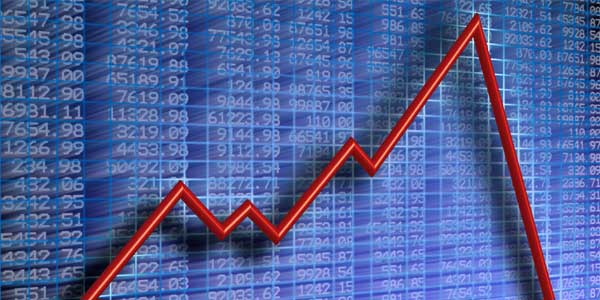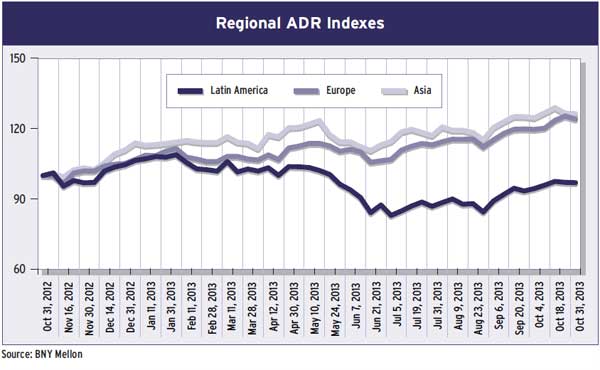CORPORATE FINANCING NEWS
The major emerging markets are attracting renewed interest from investors. The uptick comes at a time when companies from these fast-developing countries need capital to grow and are turning to depositary receipts to tap into the deeper capital markets in the developed world. DR bankers say there has been a steady increase in companies deciding to list on exchanges in the United States and Europe, and they are optimistic that this momentum will carry over into 2014.
Companies based in Asia led capital raising using DRs in the third quarter, and several companies from the region saw their DR offering price more than quadruple year-to-date, according to BNY Mellon.

Christopher Kearns, CEO of BNY Mellon’s Depositary Receipts business, says: “There was a rush of capital-raising activity in the DR market from Asia in the third quarter, and the region will probably dominate in the fourth quarter as well.”
The best overall performing DR through the first nine months of this year was Denmark’s Vestas Wind Systems, with a gain of 341%, which just barely surpassed the gain of South Korea’s Hanwha SolarOne, followed by China Sunergy, which was up 323%. Taiwan’s Inotera Memories and Himax Technologies also more than quadrupled in value, while China’s JinkoSolar tripled its offering price.
STRONG QUARTER
Companies coming to market in the third quarter raised more than $2 billion, up from $1.4 billion in the second quarter. Taiwan’s Fubon Financial Holding led with a global depositary receipts (GDR) offering of $850 million.
“The pipeline of prospective new issues is fairly healthy, looking six months out,” Kearns says. The New York Stock Exchange and the Nasdaq stock market have been competing with Hong Kong to host the initial public offering of Chinese e-commerce company Alibaba Group Holding. The offering is expected to value the company at more than $75 billion.
“We are seeing a steady increase in companies coming to market, as well as investor appetite for those offerings, both from developed and developing countries,” Kearns says. IPOs from outside of Asia included Mexican discount airline Volaris, whose $500 million IPO was done 80% in DRs, and South African transport software and hardware management company MiX Telematics, which listed ADRs on the NYSE.
BNY Mellon introduced unsponsored DRs for emerging and frontier market companies such as Zambia’s Copperbelt Energy and Zambeef Products, as well as South African food and beverage company Famous Brands and furniture retailer Lewis.
EMERGING TREND
Unlike the US IPO market, which has reached its highest level of activity since the financial crisis, the pickup in capital raising using DRs has been more subdued, says Dennis Bon, global head of depositary receipts at J.P. Morgan. “However, we are beginning to see increased activity in emerging markets, which bodes well for 2014,” he says.
Tinkoff Credit Systems sold more than $1 billion of shares in October in the first IPO by a Russian company in London in 11 months. The offering included $175 million of new shares in the form of depositary receipts. Tinkoff, an online bank modeled on Capital One of the United States, is a leader in credit cards. Most of its customer base, which spreads across Russia, comes from outside of Moscow and St. Petersburg.
“A significant number of Russian privatizations could occur in the months ahead, with some potential GDR issues,” Bon says. A number of IPOs from China-based companies using ADRs have also priced recently. “The resurgence of Russian and Chinese issuers is an important new development in the DR market this year,” Bon says.
India, South Korea and Taiwan also could produce some new DR issues, Bon adds. New Delhi recently announced a two-year pilot program to allow unlisted Indian companies to raise capital abroad and list on overseas exchanges without listing in the home market.
Developing Europe and Japan also should show more DR activity as their economies improve, Bon says.
FOLLOW-ON ISSUES
Nancy Lissemore, managing director and global head of depositary receipt services at Citi, says: “There has been a significant increase in DR follow-on offerings, which accounted for 60% of DR capital raised so far this year. Most of the capital raised via DRs last year was in IPOs.”
In the first nine months of this year, the total value of capital raised through DRs was $5.8 billion, a decrease of 9% from the same period last year, Lissemore says. For the global equity capital markets as a whole, there was a 17% increase in the amount of capital raised through the third quarter, reflecting a pickup in Europe, she says.
Citi Research’s latest quarterly survey of institutional investors found that European equities are most in favor, with emerging Asia Pacific in second place, and US stocks in third, based on expectations for performance in 2014. “Investor sentiment helps in doing IPOs,” Lissemore says.
In terms of the number of new offerings, Asia should dominate, Lissemore says, although there could be a large offering from another region. “There is a strong pipeline of technology and telecom companies from China, as well as financials and semiconductor manufacturers from Taiwan,” she says. “In addition, there are energy companies from Russia and real estate companies from Dubai that could enter the market.”
In October, Voxeljet, a German company that provides high-speed, large-format 3D printers to the automotive and manufacturing industries, selected Citi as depositary bank for its NYSE-listed ADRs. The company raised $97.2 million of capital, and its shares doubled in price in their market debut on October 18.
DEAL TOTAL RISES
Edwin Reyes, global head of depositary receipts at Deutsche Bank, says: “There has been an increase in the number of DR capital-raising deals year-to-date, with 23 deals this year, versus 16 such deals in the same period of 2012.”
Although the value of DR capital raised is running behind last year’s level, Reyes notes that Sberbank’s $3.5 billion share sale (the amount raised via DRs) in September 2012 had an outsized effect on last year’s total.
“This year’s IPO after-market performance has been strong, which could provide renewed impetus for other companies to raise capital,” Reyes says. “The outlook continues to improve.”
The $2.7 billion IPO of Britain’s Royal Mail, which jumped 38% in its first day of trading on October 11, was the largest IPO in Europe since Glencore’s $10 billion London listing in May 2011, ahead of its merger with Xstrata. “We have witnessed some early signs that companies from Western Europe are considering Level 2 and Level 3 listings,” Reyes says.
Companies based in emerging markets accounted for 39% of global capital raised in the year-to-date, he says. The regulatory changes that India is introducing may lead to interest in both capital- and non-capital-raising deals involving DRs, Reyes adds.
Infrastructure companies in emerging markets will need to raise capital to meet the needs of their growing countries, Reyes says. So far this year, DR issuance has come from a broad range of industry sectors. The most active sectors worldwide in the next six months will be technology, financials, healthcare, real estate and industrials, Reyes predicts.
Globally, 108 billion DRs valued at $1.9 trillion were traded in the first three quarters of 2013, according to BNY Mellon. That represents a 3% decline in the number of DRs and a 7% decline in the value of transactions, compared with the same period a year earlier.
Trading volume is correlated with market volatility, which has been lower this year, bankers say. They note that Europe is debating a financial transactions tax, which could affect volume and market sentiment.




